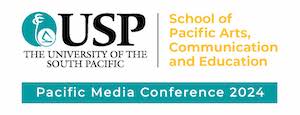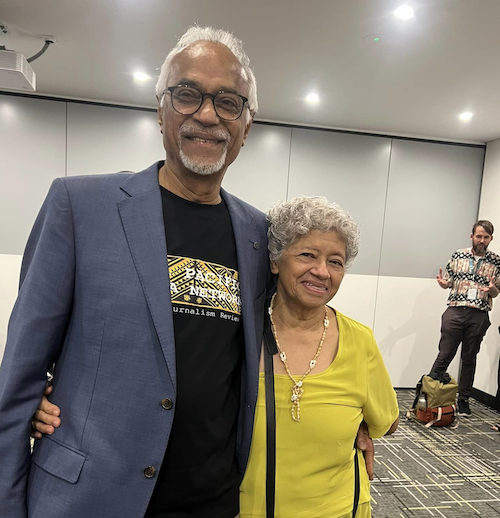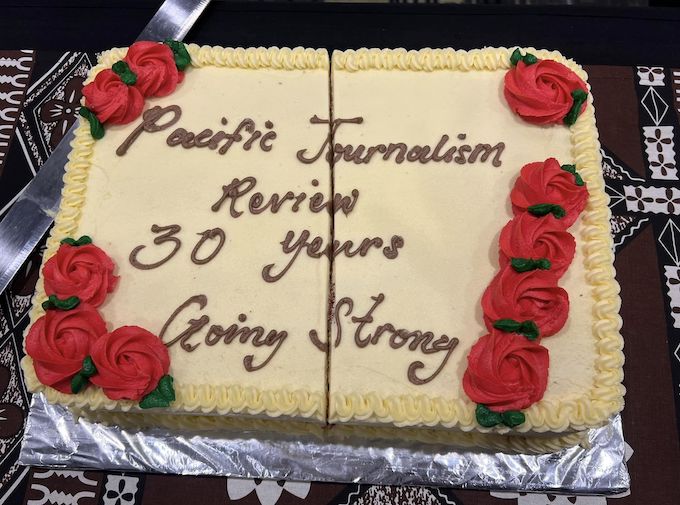Professor Vijay Naidu’s speech celebrating the launch of the 30th anniversary edition of Pacific Journalism Review at the Pacific International Media Conference in Suva, Fiji, on 4 July 2024. Dr Naidu is adjunct professor in the disciplines of development studies and governance in the School of Law and Social Sciences at the University of the South Pacific.
ADDRESS: By Professor Vijay Naidu
I have been given the honour of launching the 30th anniversary edition of the Pacific Journalism Review (PJR) at this highly significant gathering of media professionals and scholars from the Asia Pacific region.
I join our chief quests and others to commend and congratulate Dr Shailendra Singh, the head of USP Journalism, and his team for the organisation of the 2024 Pacific International Media Conference.
This evening, we are also gathered to celebrate the 30th birthday of Pacific Journalism Review/Te Koakoa.

At the outset, I would like to warmly congratulate and thank PJR designer Del Abcede for the cover design of 30th anniversary issue as well as the striking photoessay she has done with David Robie.
Hearty congratulations too to founding editor Dr David Robie and current editor Dr Philip Cass for compiling the edition.
The publicity blurb about the launch states:
“USP Journalism is proud to celebrate this milestone with a journal that has been a beacon of media excellence and a crucial partner in fostering journalistic integrity in the Pacific.”
This is a most apt description of the journal, and what it has fostered over three decades.
Dr Lee Duffield and others have written comprehensively on the editorials and articles covered by the Pacific Journalism Review.

I will just list some of the diverse subject matter covered over the past 10 years:
- PJR edition celebrating the journal’s existence for 20 years with the coverage of political journalism in the Asia Pacific — a book edition (2015);
- Documentary Practice in the South Pacific (2015);
- Endangered Journalists (2016);
- Journalism Education in the Pacific (2016);
- Climate Change in Asia-Pacific (2017);
- Journalism Education in Asia-Pacific (2017);
- Disasters, Cyclones and Communication (2018);
- Journalism Under Duress (2018);
- Terrorism Dilemmas and Democracy (2019);
- Media Freedom in Melanesia (2020);
- Climate Crisis and Corona Virus: Rethinking the social world (2020);
- Pacific Crises: Covid, Climate Emergency and West Papua (2021);
- Media Change, Adaptation and Culture (2022);
- Governance, Disinformation and Training (2023); and
- Gaza, genocide and media — PJR 30 years on, another special double edition (2024)
The editorial in the 30th anniversary double edition manifests this focus — “Will journalism survive?”, by David Robie

Unfolding genocide
Mainstream media, except for Al Jazeera, have collectively failed to provide honest accounts of the unfolding genocide in Gaza, as well as settler violence, and killings in the West Bank. International media stand condemned for its complicity in the gross human rights violations in Palestine.
The media have been caught out by the scores of reports directly sent from Gaza of the bombings, maiming and murder of mainly women, children and babies, and the turning into rubble of the world’s largest open-air prison.

The widespread protests the world over by ordinary citizens and university students clearly show that the media is not trusted.
Can the media survive? Indeed!
These are not the best of times for the media.
“At the time when we celebrated the second decade of the journal’s critical inquiry at Auckland University of Technology with a conference in 2014, our theme was ‘Political journalism in the Asia Pacific’, and our mood about the mediascape in the region was far more positive than it is today,” writes David.
“Three years later, we marked the 10th anniversary of the Pacific Media Centre, with a conference and a rather gloomier ‘Journalism under duress’ slogan.”
The editorial continues:
“Gaza has become not just a metaphor for a terrible state of dystopia in parts of in the world, it has also become an existential test for journalists — do we stand up for peace and justice and the right of a people to survive under the threat of ethnic cleansing and against genocide, or do we do nothing and remain silent in the face of genocide being carried out with impunity in front of our very eyes? The answer is simple surely.
“And it is about saving journalism, our credibility and our humanity as journalists.” (emphasis added).

Contemporary issues
Besides the editorial, the 30th anniversary edition continues the PJR tradition of addressing contemporary issues head on with 11 research articles, 2 commentaries, 7 book reviews, a photo-essay, 2 obituaries of Australia’s John Pilger and West Papua’s Arnold Ap, and 4 frontline pieces. A truly substantial double issue of the journal.
The USP notice on this 30th anniversary launch says “30 years and going strong”. Sounds like the Johnny Walker whisky advertisement, “still going strong”. This is an admirable achievement as well as in PJR’s future.
It is in contrast to the NZ Journalism Review (University of Canterbury), for example, which survived only for nine years.
Founded at the University of Papua New Guinea in 1994 by David Robie, PJR was published there for four years and at the University of the South Pacific for a further four years, then at Auckland University of Technology for 18 years before finally being hosted since 2021 at its present home, Asia Pacific Media Network.
According to Dr Robie, Pacific Journalism Review has received many good wishes for its birthday. Some of these are published in this journal. For a final message in the editorial, he recalled AUT’s senior journalism lecturer Greg Treadwell who wrote in 2020:
“‘Many Aotearoa New Zealand researchers found their publishing feet because PJR was dedicated to the region and interested in their work. PJR is central to journalism studies, and so to journalism and journalism education, in this country and further abroad. Long may that continue’.
“In answer to our editorial title: Yes, journalism will survive, and it will thrive through new and innovative niche forms, if democracy is to survive.
“Ra whānau Pacific Journalism Review!

Steadfast commitment
I have two quick remaining things to do: Professor Wadan Narsey’s congratulatory message, and a book presentation.
Professor Narsey pays tribute to David Robie for his steadfast commitment to Pacific journalism and congratulates him for the New Zealand honour bestowed on him in the King’s Birthday honours. He is very thankful that David published 37 of his articles on a range of issues during the dark days of censorship in Fiji under the Bainimarama and Sayeed-Khaiyum dictatorship.
I wish to present a copy of the recently published Epeli Hau’ofa: His Life and Legacy to Professor David Robie and Del Abcede to express Claire Slatter and my profound appreciation of the massive amount of work they have done to keep PJR alive and well.
It is my pleasure to launch the 30th anniversary edition of PJR.
‘Far more than a research journal’
In response, Dr Robie noted that PJR had published more than 1100 research articles over its three decades and it was the largest single Pacific media research repository but it had always been “far more than a research journal”.
“As an independent publication, it has given strong support to investigative journalism, sociopolitical journalism, political economy of the media, photojournalism and political cartooning — they have all been strongly reflected in the character of the journal,” he said.
“It has also been a champion of journalism practice-as-research methodologies and strategies, as reflected especially in its Frontline section, pioneered by retired Australian professor and investigative journalist Wendy Bacon.
“Keeping to our tradition of cutting edge and contemporary content, this anniversary edition raises several challenging issues such as Julian Assange and Gaza.”
He thanked current editor Philip Cass for his efforts — “he was among the earliest contributors when we began in Papua New Guinea” — and the current team, assistant editor Khairiah A. Rahman, Nicole Gooch, extraordinary mentors Wendy Bacon and Chris Nash, APMN chair Heather Devere, Adam Brown, Nik Naidu and Gavin Ellis.

He also paid tribute to many who have contributed to the journal through peer reviewing and the editorial board over many years — such as Dr Lee Duffield and professor Mark Pearson of Griffith University, who was also editor of Australian Journalism Review for many years and was an inspiration to PJR — “and he is right here with us at the conference.”
Among others have been the Fiji conference convenor, USP’s associate professor Shailendra Singh, and professor Trevor Cullen of Edith Cowan University, who is chair of next year’s World Journalism Education Association conference in Perth.
Dr Robie also singled out designer Del Abcede for special tribute for her hard work carrying the load of producing the journal for many years “and keeping me sane — the question is am I keeping her sane? Anyway, neither I nor Philip would be standing here without her input.”

This post was originally published on Asia Pacific Report.